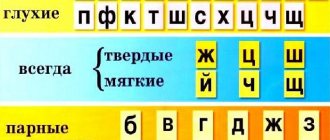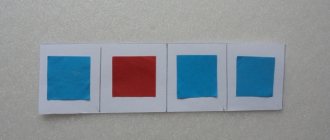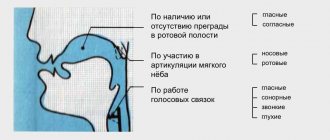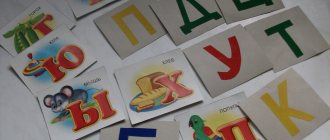- home
- Directories
- Handbook of Russian for elementary school
- Sounds and letters
- Consonant sounds and letters representing them
- Soft and hard consonants
Consonants can be hard or soft .
Many consonants are paired in softness-hardness , i.e. in different words they can soften or become hard. In transcription, the softness of a consonant is indicated by the [ ' ] symbol.
Table of consonant sounds, paired and unpaired by hardness/softness:
| Consonant clusters | Doubles | Unpaired |
| Solid | [b], [c], [d], [d], [h], [k], [l], [m], [n], [p], [p], [s], [t ], [f], [x] | [zh], [w], [ts] |
| Soft | [b'], [c'], [g'], [d'], [z'], [k'], [l'], [m'], [n'], [p'], [p'], [s'], [t'], [f'], [x'] | [th'], [h'], [h'] |
In writing, the hardness of consonant sounds is indicated by the vowels a, o, u, ы, e (which come after the consonant sound) - park [ park], rota [ rota ] , puma [ puma ], kry nka [little jar], s er [sir].
The softness of consonant sounds in writing is indicated by:
- soft sign - shallow [ m'el'], pal that [pal'to], written [ p'is'm'eny']
- vowels e, e, i, yu, i - p e n [p'en'], sv e kla [sv'okla], p i t [p'it'], k l u in [kl'uv], pl i ska [pl'aska].
In addition, consonant sounds paired in hardness/softness can be softened before some soft consonants - z [z'] , s [s'] , n [n'] , t [t'] , l [l'] .
For example: pes n ya [p'es'n'a], es l i[y'es'l'i], tail ik [khvos't'ik] and others.
Also, the consonant [n'] will be soft before the consonant letters ch and shch , while a soft sign is not written between them: donut [pon'ch'ik], racer [gon'sch'ik].
Remember that consonants unpaired in hardness-softness remain only hard or only soft (regardless of whether there is a soft sign after them or what vowel follows them).
Hard unpaired consonants always remain hard.
For example:
[zh] - heat [heat], yellow [yellow']
[sh] - ball [ball], sew [shy'u]
[ts] - heron [heron], circus [circus]
Soft unpaired consonants always remain soft.
For example:
[th'] - yogurt [y'ogurt], my [my']
[h'] - hour [h'as], check [ch'ek]
[sch'] - pike [sch'uka], gap [sch'el']
Share with friends on social networks:
Hard and soft consonants
Our train arrived at station No. 1. But here there was a commotion! Consonant sounds were traveling with us on the train. At the station they need to change seats: soft consonants into a bus with soft seats, and hard ones into a bus with hard seats. There are vowel sounds near the buses. Based on them, the consonants should take their places.
But soft and hard consonant sounds forgot which vowels to go to.
Shall we help them? To solve the problem, you need to remember which vowels soften consonants and which ones make them hard.
Consonants are always hard if they are followed by the letters A, O, U, Y, E. For example: cotton wool, bridge, jacket, otter, mayor.
Consonant sounds will be soft if they are followed by the letters E, E, I, Yu, I: forest, dog, kitty, bale, mint. The first consonants in each of these words are pronounced softly [l'], [p'], [m'], [k'], [t'].
Now look at the picture and make the right choice.
Correct answer:
- The vowels E, E, I, Yu, I soften the consonants. This means that the red bus with these letters has soft seats. Soft consonants will sit in it.
- The letters A, O, U, Y, E make consonants hard. Therefore, the yellow bus is designed for hard consonants, and has hard seats.
We helped consonant sounds. But why is this important professor coming to us? He probably wants to communicate something.
Source
Well, guys, let's draw conclusions:
- In the Russian language, letters and sounds are divided into two groups: vowels and consonants.
- The formation of consonant sounds occurs with the help of voice and noise.
- Consonant sounds are soft and hard.
- The tongue is involved in the formation of soft consonants. Compare a couple of words: b a k – b e g. In the first word, the consonant is formed with the participation of the lips, the sound is pronounced firmly [b]. In the second option, when pronouncing a sound, the tongue rushes to the palate, producing a soft sound [b'].
- In writing, the softness of consonants is indicated by vowels: E, E, I, Yu, I and a soft sign: v e sleep, v e sla, p i la, l lyulka , v i z, root .
Have you fixed the rules? The train is signaling its departure, it's time for us to hit the road!
Vowels, softening consonants (table)
In the phonetics of the Russian language, the influence of some sounds on others is clearly expressed. Influential sounds are mainly vowels, which make consonants soft, softened, and affect the duration or sonority of the sound. Sometimes this influence is clearly audible during the pronunciation of a word - soft sounds just beg to be spoken. But in some cases it is easy to make a mistake both when pronouncing a word and when trying to write down its transcription.
The role of b and b in Russian
Let's make a stop at the Istoricheskaya station and go to visit friends: soft and hard signs. They are similar in appearance, only Kommersant has a small tail. They have different meanings. The letters themselves will explain why they do not have sounds, and what role they play in the language.
Let's first listen to what b has to say.
Now let’s listen to Kommersant’s
Guys, sounds are written using letters. In some cases, the pronunciation of a word and its letter form do not coincide. A word can contain more sounds than letters: the word “Christmas tree” has 4 letters, but 5 sounds, е is an iotated vowel, gives two sounds - [й'], [о]. Other examples:
1) “loader” – there are 7 letters and 6 sounds, because 2 letters “z”, “ch” are pronounced as 1 sound “sch”;
2) “mother” – 4 letters, but 3 sounds, because b has no sound;
3) “entrance” - 7 letters, 7 sounds, while Ъ has no sound, and the letter “e” gives 2 sounds [й'], [е].
To determine the number of sounds in a word and their pronunciation, make a transcription: write the sound in square brackets [ ]. Mandatory condition: write sounds as they are heard: family - [s'im'y'a], telephone - [t'il'ifon], laziness - [l'en'], battalion - [batal'on]. Comma , which is placed above to the right of the consonant, is a sign of softness of sound.
You already know about the word hyphenation rule: you cannot leave one letter on a line or move it to a new line. Incorrect: k-oshka, cat, correct: cat.
But what about the soft sign? If a word contains a soft sign, it is transferred along with the consonant. For example, the words: boy, dawn, with a soft sign in the middle of the word to transfer from one line to another, we divide it like this: boy, dawn. Aslova with b at the end: April, run we will divide for transfer like this: April, run. The soft sign is added during transfer to the preceding consonant.
Do you remember? Then let's move on.
Softening vowels
The vowels of the Russian language can be divided into pairs: a - z, u - yu, o - e, y - i, e - e. Let's do a phonetic analysis of words using one of the pairs (a - z), examining the influence of different vowels on one and the same consonant sound:
We conclude that the first vowels in a pair do not affect the softness of neighboring consonants.
Vowels, softening consonants, in table form:
| I | apple [y'apple], judge [sud'y'a], roofing [roofing], hoop [p'al'tsa] |
| Yu | lawyer [y'urist], love [l'killed'], plush [plush] |
| e | tree [y'olka], flight [pal'ot], boiled [var'ony] |
| e | lie [l'izhat'], general [g'in'iral], oyster mushrooms [v'ishyn'k'i] |
| And | fox [l'is], blue [s'in'ii], write [p'isat'] |
The softening of consonants is also provided by the grapheme “b”, which has no designation in the transcription: teacher [uch'it'il'], zealous [r'y'anyy], run [begat'].
Fun fact: Sometimes a vowel doesn't have to be close to a sound to soften it. Take for example the adjective “solid”, in which a phonetic error is most often made. Due to the phenomenon that characterizes this word, it seems that it should be pronounced accordingly. But if you try to pronounce it slowly, you will notice how, during the first movements of the tongue, the speech apparatus prepares for subsequent sounds. That is why in the transcription of the word “hard” there is an unexpected softening: [t'v'rdy]. A similar effect can be observed in words like fable [bas'n'a], glass [s't'iklo], carnation [gvoz'd'ik].
Softening defect. Work specifics. methodological development on speech therapy on the topic
Factors predisposing to the occurrence of a defect: Decreased physical hearing Immaturity of phonemic processes Impairment in the structure of the articulatory apparatus Impaired innervation (tone) of the articulatory muscles
Table In case of defective pronunciation of consonants: Hard Soft in pronunciation soft hard defect of hardness softening tongue tense spastic curved (palatalization) relaxed soft flat middle part of the back of the tongue does not fall does not rise does not bend the tip of the tongue is not expressed tone increased hypertonicity decreased hypotonicity
Preparatory stage At stage 1, we initially form in the child the concept of softness and hardness. You can show: balls - plastic and rubber or cubes - wooden and rag. The whole range of speech therapy work is carried out here - this includes the normalization of muscle tone of facial and articulatory muscles (statics, dynamics), work on breathing and the development of fine motor skills, etc. When selecting articulation exercises, we take into account the structure of the violation in pronunciation: 1. No soft ones 2. Excessive softening It is necessary to strengthen the muscles of the tongue and develop a rise in the middle part of the back of the tongue. You need to relax the muscles of the tongue, learn to lower the middle part of the back of the tongue and straighten it. Teach the tongue to move back and forth: tense, relaxed Tongue position Curved “Slide” Straight “Scapula”
Articulation exercises No soft Excessive softening House opens Curious tongue Smile - Proboscis Grin Pull the tongue to the chin Monkey Pull the tongue to the nose Bulldog Hamster Circle Fat-skinny Balls lower We clean the teeth (outside) upper Samovar Slide The wind blows from the slide Reel Chew a pancake Snake Punish the tongue Spatula Blowing on the shoulder blade Bite your tongue Pendulum Needle Swing Exercises for setting the required sound
Thank you for your attention!
Mitigation defects and their correction
A specific defect in the pronunciation of soft consonants is their replacement with paired hard ones (“dada”, “tota”, “utuk”, “lantern” instead of uncle, aunt, iron, lantern). A technique for correcting this defect, based on imitation, involves auditory perception of soft sounds and visual perception of the articulation of these phonemes when comparing them with paired hard phonemes (pa-pya, ma-mya, fa-fya, apa-apya, ama-amya, afa- afya, etc.). It should be explained to the child that when pronouncing hard labial sounds, the tongue has a flat shape, while when pronouncing soft sounds, the tip of the tongue rests on the lower incisors, and the back arches towards the hard palate. With your mouth slightly open, you need to show the child in front of the mirror the difference in the position of the tongue and encourage him to reproduce what he saw.
This is followed by a detailed repetition by the speech therapist of syllables with labial and lingual-dental paired soft consonants: pa-pya, apa-apya, ap-ap, ta-tya, ata-atya, at-at, ma-mya, ama-amya, fa -fya, afa-afya, af-af, etc. If the child successfully reproduces soft consonant sounds, it is advisable to immediately use words with soft consonants (five, Katya, ball, etc.).
If direct imitation proves ineffective, a workaround can be tried. The child is asked to pronounce the vowel and, and then the syllable pi. If there is a softening of the phoneme p in the position before the vowel u, the child should be asked to repeat the same syllable several times in a whisper, gradually shortening the y, which may result in a distinct p', with some aspiration. Then you should move on to the sound combination api, which should be pronounced first loudly, then in a whisper, and finally, so that the first vowel is pronounced loudly, and the second - in a whisper and briefly. This way you can get the combination ap. Having consolidated the soft sound p-p' obtained in this way, you can move on to the open syllable pya, first separating the consonant phoneme from the vowel (p'____a), and then merging them.
Then you can enter syllables with other vowels and words. Next, similar work is carried out on other labial soft consonants (m', f', v').
§9. Positional changes of sounds
Strong-weak positions for vowels. Positional changes of vowels. Reduction
People do not use spoken sounds in isolation. They don't need it. Speech is a sound stream, but a stream organized in a certain way. The conditions in which a particular sound appears are important. The beginning of a word, the end of a word, a stressed syllable, an unstressed syllable, a position before a vowel, a position before a consonant - these are all different positions. We will figure out how to distinguish between strong and weak positions, first for vowels, and then for consonants.
A strong position is one in which sounds do not undergo positionally determined changes and appear in their basic form. A strong position is allocated for groups of sounds, for example: for vowels, this is a position in a stressed syllable. And for consonants, for example, the position before vowels is strong.
For vowels, the strong position is under stress, and the weak position is unaccented . In unstressed syllables, vowels undergo changes: they are shorter and are not pronounced as clearly as under stress. This change of vowels in weak position is called reduction . Due to reduction, fewer vowels are distinguished in the weak position than in the strong position.
The sounds corresponding to stressed [o] and [a] after hard consonants in a weak, unstressed position sound the same. “Akanye” is recognized as normative in the Russian language, i.e. non-distinction between O and A in an unstressed position after hard consonants.
Compare:
- under stress: [house] – [dam] – [o] ≠ [a].
- without accent: [dama´] -home´- [gave´] -gave´ – [a] = [a].
The sounds corresponding to stressed [a] and [e] after soft consonants in a weak, unstressed position sound the same. The standard pronunciation is “hiccup”, i.e. inability to distinguish between E and A in an unstressed position after soft consonants.
Compare:
- under stress: [m'ech'] - [m'ach'] – [e] ≠.
- without accent: [m'ich'o´m]- sword´m - [m'ich'o´m]- ball´m - [and] = [and].
- But what about the vowels [i], [s], [u]? Why was nothing said about them? The fact is that these vowels in a weak position are subject to only quantitative reduction: they are pronounced more briefly, weakly, but their quality does not change. That is, as for all vowels, an unstressed position for them is a weak position, but for a schoolchild these vowels in an unstressed position do not pose a problem.
Compare:
[ski´ly], [in _lu´zhu], [n'i´t'i] – in both strong and weak positions the quality of vowels does not change. Both under stress and in unstressed position we clearly hear: [ы], [у], [и] and we write the letters that are usually used to denote these sounds.
Discussing the problem of interpretation
What vowel sounds are actually pronounced in unstressed syllables after hard consonants?
When performing phonetic analysis and transcribing words, many guys express bewilderment. In long polysyllabic words, after hard consonants, it is not the sound [a] that is pronounced, as school textbooks say, but something else.
They are right.
Compare the pronunciation of words: Moscow - Muscovites. Repeat each word several times and listen to what vowel sounds in the first syllable. With the word Moscow everything is simple. We pronounce: [maskva´] – the sound [a] is clearly audible. What about the word Muscovites? In accordance with the literary norm, in all syllables except the first syllable before stress, as well as the positions of the beginning and end of the word, we pronounce not [a], but another sound: less distinct, less clear, more similar to [s] than to .
In the scientific tradition, this sound is designated by the symbol [ъ]. This means that in reality we pronounce: [mjlako´] - milk´, [khrasho´] - good´, [kalbasa´] - sausage´. I understand that by giving this material in textbooks, the authors tried to simplify it. Simplified. But many children with good hearing, who clearly hear that the sounds in the following examples are different, cannot understand why the teacher and the textbook insist that these sounds are the same. In fact:
[vada´] – water´ – [v’d’inoy’] – water´y: [a]≠[ъ] [wood´] – firewood´ – [dr’v’ino´y’] – wood´y: [a] ≠[ъ]
A special subsystem consists of the realization of vowels in unstressed syllables after sibilants. But in the school course this material is not presented at all in most textbooks.
What vowel sounds are actually pronounced in unstressed syllables after soft consonants?
I feel the greatest sympathy for the children who study from textbooks that suggest in place of A, E, O after soft consonants to hear and transcribe the sound “and, inclined to e.” I consider it fundamentally wrong to give schoolchildren as the only option the outdated pronunciation norm - “ekanya”, which is found today much less often than “icanya”, mainly among very elderly people. Guys, feel free to write in an unstressed position in the first syllable before the stress in place of A and E - [i].
After soft consonants in other unstressed syllables, except for the position of the end of the word, we pronounce a short weak sound reminiscent of [i] and denoted as [b]. Say the words eight, nine and listen to yourself. We pronounce: [vo´s'm'] - [b], [d'e´v't'] - [b].
Do not confuse:
Transcription marks are one thing, but letters are another. The transcription sign [ъ] indicates a vowel after hard consonants in unstressed syllables, except for the first syllable before stress. The letter ъ is a solid sign. The transcription sign [b] indicates a vowel after soft consonants in unstressed syllables, except for the first syllable before stress. The letter ь is a soft sign. Transcription signs, unlike letters, are given in square brackets.
The end of a word is a special position. It shows clearing of vowels after soft consonants. The system of unstressed endings is a special phonetic subsystem. In it, E and A differ:
Building [building] - building [building], opinion [mn'e´n'ii'e] - opinion [mn'e´n 'iya'a], sea [mo´r'e] - sea [mo´r'a], will [vo´l'a] – at will [na_vol´l'e] . Remember this when doing phonetic analysis of words.
Check:
How your teacher requires you to mark vowels in an unstressed position. If he uses a simplified transcription system, that's okay: it's widely accepted. Just don’t be surprised that you actually hear different sounds in the unstressed position.
Strong-weak positions for consonants. Positional changes of consonants
For all consonants without exception, the strong position is the position before the vowel . Before vowels, consonants appear in their basic form. Therefore, when doing a phonetic analysis, do not be afraid to make a mistake when characterizing a consonant in a strong position: [dach'a] - da´cha, [t'l'iv'i´zr] - TV, [s'ino´n 'ims] - synonyms, [b'ir'o´zy] - birches, [karz'i´ny] - baskets. All consonants in these examples come before vowels, i.e. in a strong position.
Strong positions on deafness of voicedness:
- before vowels: [there] - there, [dam] - I will give,
- before unpaired voiced [p], [p'], [l], [l'], [n], [n'], [m], [m'], [th']: [dl'a] - for, [tl'a] – aphid,
- Before [v], [v']: [svoy'] - yours, [ringing] - ringing.
Remember:
In a strong position, voiced and voiceless consonants do not change their quality.
Weak positions in deafness and voicedness:
- before paired ones according to deafness-voicing: [sla´tk'iy] - sweet, [zū´pk'i] - teeth.
- before voiceless unpaired ones: [apkhva´t] - girth, [fhot] - entrance.
- at the end of the word: [zup] - tooth, [dup] - oak.
Positional changes of consonants according to deafness-voicing
In weak positions, consonants are modified: positional changes occur with them. Voiced ones become voiceless, i.e. are deafened, and the deaf are voiced, i.e. call out. Positional changes are observed only for paired consonants.
Stunning-voicing of consonants
Voiced deafening occurs in the following positions:
- before paired deaf ones: [fsta´v'it'] – insert,
- at the end of the word: [klat] – treasure.
Voicing of the deaf occurs in the position:
- before paired voiced ones: [kaz'ba´] – mowing´
Strong positions in terms of hardness and softness:
- before vowels: [mat'] - mother, [m'at'] - crush,
- at the end of the word: [out] - out, [out'] - stench,
- before labialials: [b], [b'], [p], [p'], [m], [m'] and posterior linguals: [k], [k'], [g], [g' ], [x[, [x'] for sounds [s], [s'], [z], [z'], [t], [t'], [d], [d'], [n ], [n'], [r], [r']: [sa´n'k'i] – San'ki (born fall), [s´ank'i] – sa´nki, [bu ´lka] - bun, [bu´l'kat'] - gurgle,
- all positions for the sounds [l] and [l']: [lba] - forehead, [pal'ba] - firing.
Remember:
In a strong position, hard and soft consonants do not change their quality.
Weak positions in hardness-softness and positional changes in hardness-softness.
- before soft [t'], [d'] for consonants [c], [z], which are necessarily softened: [c't'ep'], [z'd'es'],
- before [ch'] and [sh':] for [n], which is necessarily softened: [po´n'ch'ik] - donut, [ka´m'n'sh':ik] - mason .
Remember:
In a number of positions today, both soft and hard pronunciation is possible:
- before soft front-lingual [n'], [l'] for front-lingual consonants [c], [z]: snow - [s'n'ek] and [sn'ek], to anger - [z'l'it'] and [zl'it']
- before soft front-lingual [c'], [z'] for front-lingual [t], [d] - raise - [pad'n'a´t'] and [padn'a´t'], take away - [at'n'a´t'] and [atn'a´t']
- before soft front-lingual [t'], [d'], [s'], [z'] for front-lingual [n]: vintik - [v'i´n't'ik] and [v'i´nt 'ik], pension - [p'e´n's'ii'a] and [p'e´ns'ii'a]
- before soft labials [v'], [f'], [b'], [p'], [m'] for labials: enter - [f'p'isa't'] and [fp'is´ at'], rifme (Dan.fall.) - [r'i´f'm'e] and [r'i´fm'e]
Remember:
In all cases, positional softening of consonants is possible in a weak position. It is a mistake to write a soft sign when softening consonants positionally.
Positional changes of consonants based on the method and place of formation
Naturally, in the school tradition it is not customary to present the characteristics of sounds and the positional changes that occur with them in all the details. But the general principles of phonetics need to be learned. Without this, it is difficult to do phonetic analysis and complete test tasks. Therefore, below is a list of positionally determined changes in consonants based on the method and place of formation. This material is a tangible help for those who want to avoid mistakes in phonetic analysis.
Assimilation of consonants
The logic is this: the Russian language is characterized by similarity of sounds if they are similar in some way and at the same time are nearby.
Learn the list:
[c] and [w] → [w:] – sew
[z] and [zh] → [zh:] – compress
[s] and [h'] - at the root of words → [w':] - happiness, counting - at the junction of morphemes and words → [w':h'] - comb, dishonest, with what (the preposition followed by the word is pronounced together as one word)
[s] and [w':] → [w':] - split
[t] and [c] - in verb forms → [ts:] - smiles - at the junction of prefix and root → [tss] - pour out
[t] and [ts] → [ts:] - unhook
[t] and [h'] → [h':] - report
[t] and [t] and [w':]←[c] and [h'] – counting
[d] and [w':] ←[c] and [h'] - counting
Dissociation of consonants
Dissimilarity is a process of positional change, the opposite of assimilation.
[g] and [k'] → [x'k'] – light
Simplifying consonant clusters
Learn the list:
vstv - [stv]: hello, feel zdn - [zn]: latezdts - [sc]: under the bridle - [nc]: sun ndc - [nc]: Dutch ndsh - [ns:] landscape ntg - [ng]: x-ray rdc - [rts]: heart rdc - [rch']: heart stl - [sl']: happy stn - [sn]: local
Pronunciation of sound groups:
In the forms of adjectives, pronouns, participles there are letter combinations: wow, his. Instead of g, they pronounce [v]: him, beautiful, blue. Avoid reading letter by letter. Pronounce his blue, beautiful words correctly.
Final test
What determines the quality of a vowel sound?
- From the shape of the oral cavity at the moment of pronouncing the sound
- From the barrier formed by the speech organs at the moment of pronouncing a sound
What is reduction called?
- pronouncing vowels under stress
- pronouncing unstressed vowels
- special pronunciation of consonants
For which sounds does the air stream encounter an obstacle on its path: a bow or a gap?
- In vowels
- In consonants
Can voiceless consonants be pronounced loudly?
- Yes
- No
Are the vocal cords involved in pronouncing voiceless consonants?
- Yes
- No
How many pairs of consonants are formed according to deafness and voicedness?
- 5
- 11
- 20
How many consonants do not have a voiced-voiced pair?
- 5
- 10
- 14
How many pairs do Russian consonants form according to hardness and softness?
- 10
- 15
- 20
How many consonants do not have a hard-soft pair?
- 3
- 6
- 12
How is the softness of consonants conveyed in writing?
- Special icons
- Letter combinations
What is the name of the position of a sound in a stream of speech in which it appears in its basic form, without undergoing positional changes?
- Strong position
- Weak position
What sounds have strong and weak positions?
- In vowels
- In consonants
- For everyone: both vowels and consonants
Right answers:
- From the shape of the oral cavity at the moment of pronouncing the sound
- pronouncing unstressed vowels
- In consonants
- No
- No
- 11
- 14
- 15
- 6
- Letter combinations
- Strong position
- For everyone: both vowels and consonants








